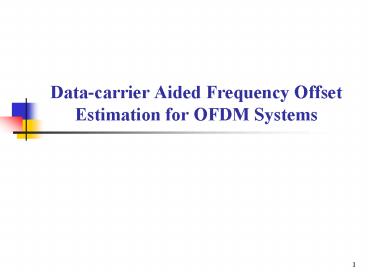Datacarrier AidedFrequency Offset Estimation for OFDM Systems PowerPoint PPT Presentation
1 / 36
Title: Datacarrier AidedFrequency Offset Estimation for OFDM Systems
1
Data-carrier Aided Frequency Offset Estimation
for OFDM Systems
2
Outline
- Motivations
- Background knowledge
- Conventional CFO estimation strategies
- Modified CFO estimation strategies
- Simulation results
- Conclusions
3
Outline
- Motivations
- Background knowledge
- Conventional CFO estimation strategies
- Modified CFO estimation strategies
- Simulation results
- Conclusions
4
Motivations
- Motivations
- The conventional carrier frequency offset
estimation methods pilot, cyclic prefix,
training symbol - Our proposed schemes adopting the received
signal on data-carriers - Providing more accurate frequency
synchronization, or reducing the pilot numbers to
raise transmitted data rate.
5
Outline
- Motivations
- Background knowledge
- Conventional CFO estimation strategies
- Modified CFO estimation strategies
- Simulation results
- Conclusions
6
Carrier Frequency Offset
- What result in carrier frequency offset (CFO)?
- Mismatch between the oscillators at the TX and RX
- Doppler frequency
- Carrier frequency offset can be divided into
- Integral part
- Fractional part
7
OFDM System Model
- The OFDM system model
S ( n )
X ( n )
x ( k )
Adding Cyclic Prefix P/S
S/P
Signal Mapper
Adding Pilots C(n) IFFT
x ( t )
DAC
Channel h ( t)
z (t )
AWGN w ( t)
Remove Cyclic Prefix S/P
r (t )
P/S
FFT
Signal Demapper
ADC
- C is pilot sequence
- h is time domain channel impulse response
- w is additive white Gaussian noise.
- N data information S(n) which have been
modulated with N modulation values X(n) on
every sub-carrier
8
OFDM System Model
- The k sample of an OFDM block generated by IFFT
N number of subcarriers Ng length of cyclic
prefix
9
UWB Channel Model
cluster decay factor path decay
factor cluster arrival rate the
arrival rate of path within each cluster
- Four environments in this UWB channel model
- CM1 model is based on LOS (0-4m) channel
measurements in 2 - CM2 model is based on NLOS (0-4m) channel
measurements in 2 - CM3 model is based on NLOS (4-10m) channel
measurements in 2, - and NLOS in 3
- CM4 the model generated to fit a 25nsec RMS delay
spread.
10
Outline
- Motivations
- Background knowledge
- Conventional CFO estimation strategies
- Modified CFO estimation strategies
- Simulation results
- Conclusions
11
Sensitivity for Carrier Frequency Offset
- The OFDM system model with CFO
S ( n )
X ( n )
x ( k )
Adding Cyclic Prefix P/S
S/P
Signal Mapper
Adding Pilots C(n) IFFT
x ( t )
DAC
Channel h ( t)
z (t )
AWGN w ( t)
Remove Cyclic Prefix S/P
r (t )
P/S
FFT
Signal Demapper
ADC
- is the ratio of the actual
frquency offset to the sub-carrier spacing
12
Sensitivity for Carrier Frequency Offset
- The k-th received sample of the m-th symbol is
given by
FFT
13
Pilot tone - aided CFO Estimation
- PTA CFO estimation
- Let P denote the set of indexes of the Np
pilot carriers
f
Q
R1
R2
Rm
RmD
Pilot3 (n3)
Pilot2 (n2)
I
Pilot1 (n1)
t
14
Pilot tone - aided CFO Estimation
- PTA with weighting (PTAW) CFO estimation
- Let P denote the set of indexes of the Np
pilot carriers
f
Q
I
15
Cyclic Prefix - based CFO Estimation
- CL is the channel length
16
Outline
- Motivations
- Background knowledge
- Conventional CFO estimation strategies
- Modified CFO estimation strategies
- Simulation results
- Conclusions
17
Modified PTAW
f
R1
R2
Rm
RmD
t
18
Modified PTAW
Step2
19
Modified PTAW
Step3
Each data-subcarrier d(n) has M candicates
,i1M
Step4
20
Modified CPB
21
Modified CPB
Step3
Each data-subcarrier d(n) has M candicates
,i1M
Step4
22
Outline
- Motivations
- Background knowledge
- Conventional CFO estimation strategies
- Modified CFO estimation strategies
- Simulation results
- Conclusions
23
Optimum L for CPB Method
CM1
24
Optimum L for CPB Method
CM3
25
Discussion of Pilot Numbers
CM1
26
Discussion of Pilot Numbers
CM3
27
Performance Comparison
CM1 BPSK
28
Performance Comparison
CM1 QPSK
29
Performance Comparison
CM1 8PSK
30
Performance Comparison
CM3 BPSK
31
Performance Comparison
CM3 QPSK
32
Performance Comparison
CM3 8PSK
33
Outline
- Motivations
- Background knowledge
- Conventional CFO estimation strategies
- Modified CFO estimation strategies
- Simulation results
- Conclusions
34
Conclusions
- Advantages
- The key advantages of our proposed algorithms is
to provide more accurate frequency
synchronization and reduce pilot numbers to raise
bandwidth efficiency. - Comparison with conventional methods
- The MCPB performs better than CPB (lower MSE).
- The MPTAW performs better than two traditional
pilot tone-aided methods, and we can achieve the
same performance as PTAW by less pilot numbers. - The best choices
- If there is acceptable ISI, the MCPB will be the
most suitable method to estimate CFO because it
can provide excellent MSE with its superior
resistance of ICI and constellation size. - If there is serious ISI, the MPTAW is the best
choice under this condition since it is robust to
time domain interference.
35
- Thank you
36
Reference
- 1 J. R. Foerster, Ed., Channel Modeling
Sub-committee Report Final, IEEE P802.15 SG3a
contribution. - 2 H. Chen and G.J. Pottie, "A Comparison of
Frequency Offset Tracking Algorithms for OFDM",
GLOBECOM '03, vol.2, pp. 1069-1073, Dec. 2003. - 3 K. Shi, E. Serpedin, and P. Ciblat,
Decision-directed fine synchronization for coded
OFDM systems, in Proc. IEEE International Conf.
on Acoustics, Speech, and Signal Processing.
(ICASSP04), vol. 4, pp. 365-368, 17-21 May 2004.

